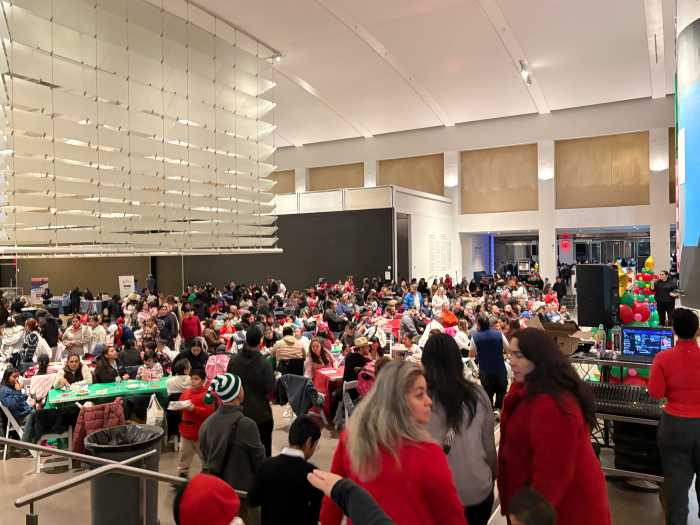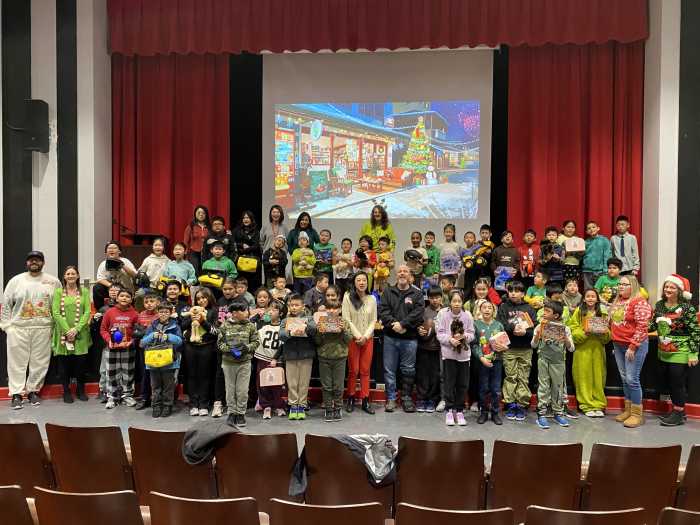By Arlene McKanic
This is one of the enigmas Gordon, a Long Island-based photographer, discovered in these mysterious, volcanic islands off the coast of South America. One of the first photos in the collection shows Gordon's party disembarking from a rubbery, Jacques Cousteau-invented Zodiac boat onto a jagged volcanic coastline on Bartholomew Island. It was one of the dryer and more decorous disembarkations, she said. From then on she moved around the islands to capture on film the booby and its adopted chick, the orange red Sally Lightfoot crab and the giant tortoise with the long neck adapted to graze on a bush that would otherwise be too high to reach. The islands, which have different names in Spanish and English and sometimes look like moonscapes, have allowed different species of the same animal to evolve, like the land and marine iguanas. The Galapagos are home to the only sea-going iguana in the world, which is descended from the land iguana. Land iguanas rafted over from South American on floating debris. When they got to the islands, some started going into the waters to partake of the algae. Over eons the sea-going land iguanas spent more time in the water, and became marine iguanas. There are many photos of them, including a close up of a prehistoric gentleman smiling in the sun, a grouping of the lizards with splashes of red on their backs – no one knows why this group of iguanas has red coloring – and a green green iguana resting atop a green green bush. There's a crowd of iguanas the exact black and gray color of the rocks they're sunning on. “Oh, there they are!” You might cry out when you finally see them.There's a photo of clumps of lava cactus sprouting, improbably, from the tufa – even Gordon marveled at how alien everything seemed. There's a portrait of a female lava lizard with bumpy skin; the lizards with the bumpy skin, Gordon explained, tend to survive longer than their smooth-skinned cousins when conditions get harsh. Again, no one knows exactly why. There are photos of sea lions, the largest Galapagos mammals, if you don't count the dolphins. Mostly they're resting on the beach and sugared with sand – each beach seems to have a different colored sand, some salt and pepper, some pure white, some actually green from the volcanic olivine deposits. You can almost hear the silence of Gordon's landscapes, which are all shades of gray, beige, white, and even pink, broken up by occasional greenery. A view of Pinnacle Rock taken at dawn shows cone shaped, pastel colored hills marching toward the horizon. Another photo has sinkholes that look like giant fossilized footprints.There are photos – by the way, all of the photos are film, not digital – of male great frigatebirds sporting their bright red gullar sacs. These sacs, which are at the throat, are used to attract females, though Gordon believes the females are more interested in the real estate the birds control. “Sometimes the trees looked like they were full of these red balloons!” She said.It takes about 20 minutes for the sacs to fill up with air. “Oh, I thought they just puff out their chest,” I said. Uh, no.Gordon was in a boat once when she saw something explode out of the water. She took the picture quickly and it turned out to be a flightless cormorant in the act of swallowing a red fish larger than its head. There's another photo of a cormorant, on land, the iridescent blue of its back feathers matching the sapphire blue of its eye.There's a photo of a gorgeous swallowtailed gull, which is the only nocturnal gull. Nobody knows why that is either, but I had a theory: The green turtles usually hatch at night to avoid the diurnal animals that might feed on them – have the swallowtailed gulls exploited this? Speaking of green turtles, there's a photo of a tiny and determined hatchling that had the bad luck to emerge from its nest during the day. It had moments to live – a frigatebird got him before he could reach the safety of the water. Gordon, who doesn't shy away from nature's ferocity in her work, admitted that this might be hard, but nature wouldn't want a turtle dumb enough to emerge in broad daylight to pass on his genes. Besides, frigatebirds have to eat. So do Sally Light foot crabs. There's a photo, at once beautiful and gruesome, of a bunch of them feasting on the carcass of a drowned booby on the beach. A couple of gray mockingbirds contend fiercely on the sand. They look like the doves on those L'Air du Temps perfume bottles but, according to Gordon, “I was surprised they didn't kill each other.” In the end, both birds just got up and walked away.The Galapagos, which belong to Ecuador, are a protected wildlife sanctuary, which is why the film “Master and Commander” had to film in Mexico. Gordon could see the difference, anyway.The Hall of Science heard of Gordon, according to Marcia Rudy, director of public programs, when she had an exhibit of butterflies at the Rockaway Artists Alliance. Some of Gordon's butterfly pics were taken in Central America, and she's photographed all over the world, including Antarctica. She wants to go to the Seychelles and Madagascar, photograph every species of penguin and find an agent who can really make her career blow up. In the meantime, her beautiful and haunting works from the Galapagos will be at the New York Hall of Science till the end of the month. Go see it. The Hall's at 47-01 111th St. in Flushing Meadows Corona Park.

































